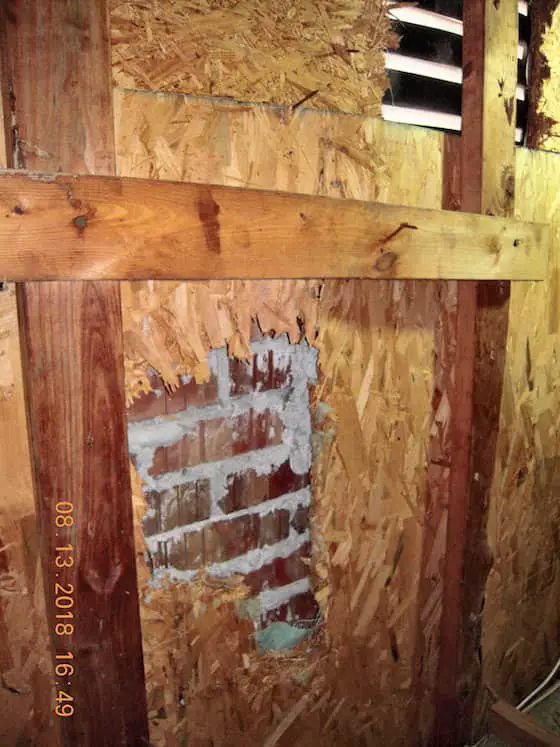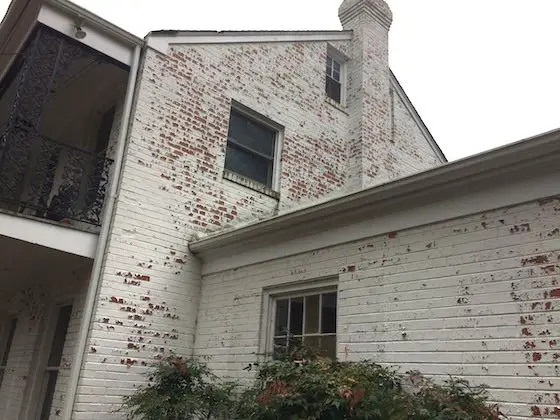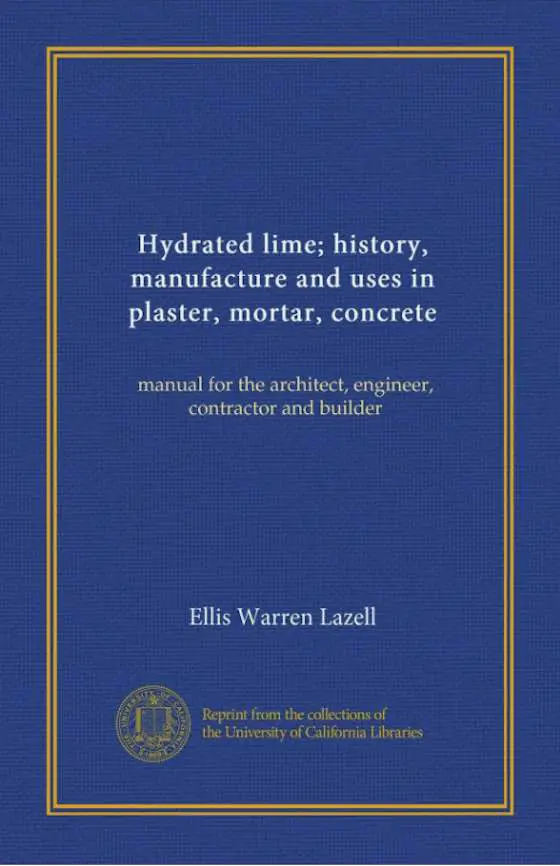Brick Veneer Leaks – Flashings

This is what the back of your brick veneer looks like. Note how it often touches up against the wood wall sheathing! This column was SO GOOD that I shared with the 31,000 subscribers who read my November 18, 2018 AsktheBuilder Newsletter. Copyright 2018 Tim Carter
"Water enters brick walls where the mortar contacts the brick. Yes, I know that looks like a solid joint, but we're talking tiny cracks."
Brick Veneer Leaks Checklist
- brick veneer has a long history of leaking
- hydrated lime mortar is the best one to use
- high-quality flashings in the brick capture the water
- unclogged weep holes are a must
Brick Veneer Leaks Are A Surprise To Many
The reason I felt that brick construction was waterproof was based on my observations. I had worked in hundreds of older brick homes. None of them had any apparent water damage. I never recall getting a complaint from a homeowner in one of these older homes about water streaming down an interior foundation wall after a moderate rainfall.
Related Links
Great Clear Liquid Brick Water Leak Preventer - Do NOT SHARE - Secret!
Free & Fast Bids
CLICK HERE to get FREE & FAST BIDS from local bricklayers.
What is Different About Brick Veneer?
There is a big difference between the solid brick houses of 100 years ago and the brick veneer houses of today.

This is a solid brick house. Behind the brick you see on the outside is a layer of 4-inch-thick concrete block or another interlocking row of brick. All you have to do to determine this is to look for the stretcher brick that is laid on end in the different rows. Copyright 2018 Tim Carter
When Were Solid Brick Houses Built?
Brick houses from the turn of the century and even those built during the 1950's where almost always solid masonry construction. That is, the exterior walls were constructed of several layers or wythes of brick. Some older houses that I worked on had brick walls that were 3 rows thick! These walls often measured 14 inches thick.
These older brick walls were massive. They were structural in nature. That is, they were designed to support the floor loads and roof loads of the structure.
New brick construction doesn't even compare. The brick on your new home or the one you might be getting ready to build is simply a facing, a veneer. Rarely are these bricks supporting anything but themselves. The walls are only one brick wide.
Where Does Water Leak Into Brick?
Water enters brick walls where the mortar contacts the brick. Yes, I know that looks like a solid joint, but we're talking tiny cracks. What's more, when you add wind to the rainfall, you can have real problems. Driving rain happens all over the U.S., but some places get driving rainstorms more than others.
Why Don't Solid Brick Houses Leak?
The older solid brick houses didn't experience leakage for two primary reasons. The water had a long way to go and the bond between the brick and mortar didn't have as many tiny cracks. Older brick construction provided an often solid barrier. The water may have to penetrate 12 to 14 inches before it got inside. By this time, the rainstorm may have long since passed.
Was the Brick Mortar Different?
Furthermore, the mortar that was used to hold together the brick years ago is very different than the mortar used today. Years ago the bricklayers blended their own mortars. They would mix sand and hydrated lime to make their mortar.
Some masons might have added Portland cement. A typical mix of this tri-blend might be five parts sand, three parts lime and one part cement.
Does Modern Mortar Contain Lime?
Most modern-day premixed bagged mortars do not have as high a lime content. They tend to have a higher proportion of cement.
This gives the mortar higher strength, but strength is rarely a factor when dealing with a brick veneer. Remember, the brick on a brick veneer home has no structural value. Strength is not a factor.
CLICK HERE to get FREE & FAST BIDS from local bricklayers.
What Does Lime Do In Mortar?
The lime in a mortar plays a special part. Its presence allows for better bonding qualities, plasticity or workability, moisture content stability and elasticity. These may sound confusing so let me explain.
Lime is a unique compound. In the dry form, it's simply a powdered form of calcium hydroxide. When this dry compound reacts with water and carbon dioxide it begins to crystallize.

This is a fantastic small book sharing exactly how you should use hydrated lime. CLICK THE IMAGE to have it delivered to your home in days.
If enough lime is present in a mortar mix, believe it or not, not all of it gets totally wet when initially mixed. Some of the lime sits around for years deep inside a mortar joint. Then, if a small crack develops, water and air might start to penetrate the brick. The lime gets wet and crystals start to grow. Soon the crack has closed up. This magical property is called autogenous healing. It can stop water leakage big time.
Did Bricklayers Know Brick Leaks?
Commercial builders and bricklayers have known for many years that brick walls are not waterproof. They have developed extensive building practices and products to capture this water and redirect it back to the exterior face of the brick. They use continuous flashings. These flashings work very much like the flashings on the roof of your house. A flashing is simply a barrier material that is unaffected by water.
How Was Brick Knowledge Taught Years Ago?
Years ago, workers who entered the construction trades did so as apprentices. The knowledge of each craft was passed down slowly and methodically. For whatever reason, this practice ended at the end of the 1950s for the most part.
Construction workers today simply don't receive the training like they used to. Knowledge about a trade is either missing or not transmitted. The result is poor performance of products or construction techniques.
A perfect example of this is bricklaying. The connection of knowledge transfer between the commercial bricklayers and the residential bricklayers is broken. Many residential bricklayers (and builders) don't have the foggiest idea why a wall flashing is an integral part of a brick wall.
What is the Worst Brick Flashing?
This is why you see builders and bricklayers use the inexpensive black garbage bag type plastic. This is why the joints where this plastic overlaps are not sealed. This is why there is no flashing above window or door headers and below window and door sills. It is a nightmare. Just ask any homeowner who has a leaking brick house.
You now know that the garbage bag plastic is worthless. It tears easily. It becomes brittle. Some builders (very few) switched to a thicker PVC flashing five to 10 years ago thinking that this would solve the problem. Heck, I used this stuff. Recent studies have shown that this material is not much better than the worthless garbage bag type plastic. The PVC looses its plasticity within five to 10 years and becomes brittle. Brick movement can cause tears.
Are There Great Brick Flashing Materials?
There are good flashing materials available. They cost a little more than the bad flashing materials. They take a little more time to install. But, if done properly, you will have a leak free brick home.
What are the Best Brick Flashings?
Some of the best brick flashings incorporate a very thin piece of copper embedded in an asphalt impregnated mat. Other flashings are high-density cross laminated polyethylene membranes. Some of the materials are modified asphalts with rubber. They all are made so that overlapping joints, inside and outside corner details can be easily sealed.
How Does a Brick Flashing Work?
A brick flashing is designed to intercept, capture, and divert the water flowing down the back of the brick. It redirects the water back out to the front of the wall.
Let's assume that you've put in your perfect flashing. That is only part of the job. Now we need to get the water back from behind the wall. We need to create little tunnels and make sure that the pathways to the tunnels are not blocked.
What Happens to Excess Mortar?
When laying brick, if too much mortar is used, excess mortar can fall behind the wall as the brick is pushed into place. These mortar droppings can't be removed.

This is what the back of your brick veneer looks like. Note how the excess mortar often touches up against the wood wall sheathing! Copyright 2018 Tim Carter
Can A Hidden Mortar Dam Form Behind the Wall?
If enough mortar falls behind the wall, a solid barrier can form. The trapped water then looks for a place to go.
I've seen where this water has built up, entered the frame wall and traveled under a hardwood floor some 10 to 12 inches. The water finds a seam in the subfloor and then drips into the basement. Imagine what will happen to this house in a short period of time!
What are Brick Weep Holes?
Weep holes allow water to escape to the outside of a brick wall. They should be placed as low as possible where a course of brick sits on top of a horizontal barrier (foundation, or a window or door lintel.) These weep holes should be placed every 24 inches.
I would also give serious consideration to a specialty product as well. This product is a plastic netting that fits behind the first several courses of brick immediately behind the weep holes. The netting is cut in such a fashion that it has different horizontal levels. Mortar droppings fall onto these levels and build up. However, the water can move sideways and then fall through the mesh. It hits the flashing and flows uninterrupted through the weep holes.
If you want a leak-free brick home, you must obtain some of the literature I have listed. Also, obtain some of the product literature brochures for clear, crisp illustrations of how these specialized flashings work. A little homework on your part will pay huge dividends.
CLICK HERE to get FREE & FAST BIDS from local bricklayers.


5 Responses to Brick Veneer Leaks – Flashings